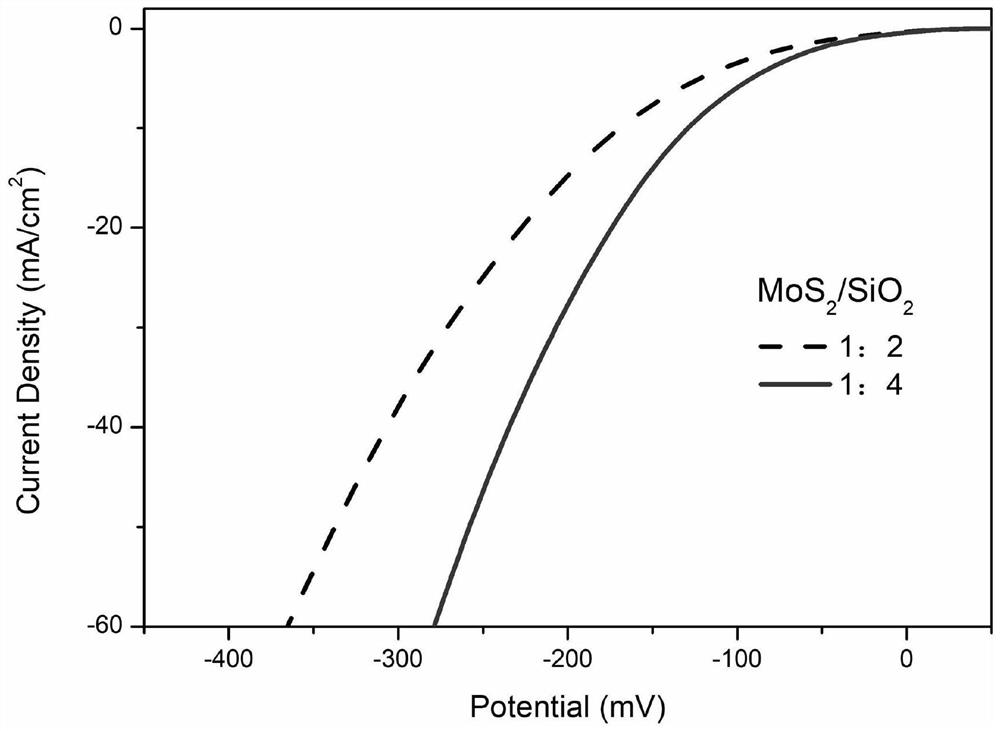Preparation method of molybdenum disulfide with nanopore structure
A nanoporous structure, molybdenum disulfide technology, applied in molybdenum sulfide, electrodes, electrolysis process, etc., can solve the problems of poor conductivity, few catalyst active sites, low catalytic efficiency, etc., and achieve strong conductivity, good catalytic performance and Stability, effect of high active site density
- Summary
- Abstract
- Description
- Claims
- Application Information
AI Technical Summary
Problems solved by technology
Method used
Image
Examples
Embodiment 1
[0019] A preparation method of block molybdenum disulfide catalyst with nanopore structure, specifically as follows:
[0020] 1) Weigh commercial high-purity molybdenum disulfide powder and nano-silica powder (particle size 10-100 nanometers), and mix the two according to the mass ratio of 1:2.
[0021] 2) Weigh the mixed powder, put it into a ball mill jar together with balls and milling aids, and after vacuuming, pass in argon protection, and carry out wet milling in a high-energy ball mill for 12 to 48 hours.
[0022] 3) After ball milling, use a sieve to separate the slurry and balls, then transfer the slurry to a vacuum drying oven, and dry it in vacuum at 40-60°C for 2-8 hours.
[0023] 4) Use an agate mortar to grind the dried powder for 1-5 minutes.
[0024] 5) Weigh 1.0-3.0 g of the mixed powder, press it into a cylinder under the condition of 1 MPa in a powder tablet press, and wrap it with an inert metal sheet or polytetrafluoroethylene.
[0025] 6) Grinding the s...
Embodiment 2
[0037] A preparation method of block molybdenum disulfide catalyst with nanopore structure, specifically as follows:
[0038] 1) Weigh commercial high-purity molybdenum disulfide powder and nano-silica powder (particle size 10-100 nanometers), and mix the two according to the mass ratio of 1:4.
[0039] 2) Weigh the mixed powder, put it into a ball mill jar together with balls and milling aids, and after vacuuming, pass in argon protection, and carry out wet milling in a high-energy ball mill for 12 to 48 hours.
[0040] 3) After ball milling, use a sieve to separate the slurry and balls, then transfer the slurry to a vacuum drying oven, and dry it in vacuum at 40-60°C for 2-8 hours.
[0041] 4) Use an agate mortar to grind the dried powder for 1-5 minutes.
[0042] 5) Weigh 1.0-3.0 g of the mixed powder, press it into a cylinder under the condition of 1 MPa in a powder tablet press, and wrap it with an inert metal sheet or polytetrafluoroethylene.
[0043] 6) Grinding the s...
Embodiment 3
[0055] The molybdenum disulfide sheet with nanoporous structure prepared in Examples 1 and 2 was adhered to the top of a glassy carbon rod as a working electrode, the silver / silver chloride electrode was used as a reference electrode, and the stone-milled rod was used as a counter electrode for electrochemical testing.
[0056] Such as figure 1 As shown, the experimental results show that the prepared molybdenum disulfide has a lower hydrogen evolution overpotential (the exchange current density is 10mA / cm 2 The overpotential was 162mV), and the small Tafel slope (41mV), showing that it has good catalytic performance, and the material still maintains the overpotential and Tafel slope similar to the initial value after 2000 cycles of linear voltammetry scanning , indicating that it has good stability.
PUM
| Property | Measurement | Unit |
|---|---|---|
| Granularity | aaaaa | aaaaa |
Abstract
Description
Claims
Application Information
 Login to View More
Login to View More - R&D
- Intellectual Property
- Life Sciences
- Materials
- Tech Scout
- Unparalleled Data Quality
- Higher Quality Content
- 60% Fewer Hallucinations
Browse by: Latest US Patents, China's latest patents, Technical Efficacy Thesaurus, Application Domain, Technology Topic, Popular Technical Reports.
© 2025 PatSnap. All rights reserved.Legal|Privacy policy|Modern Slavery Act Transparency Statement|Sitemap|About US| Contact US: help@patsnap.com

